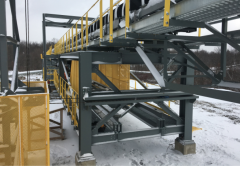Allegheny Mineral’s Slippery Rock Quarry Installs a Mile-Long Overland Conveyor at its New Operation.
By Mark S. Kuhar
|
|
| Conveyor drive |
Overland belt conveyors have been widely used as a cost-effective method to transport bulk materials. Allegheny Mineral Corp. – a leading supplier of aggregates to the Pennsylvania market – certainly understands these economics, and for the past 20 years, has been using a 3,100-ft. long, 42-in. conveyor to transport crushed limestone from an existing primary crusher to its processing plant and storage yard at its Slippery Rock Quarry in northwestern Pennsylvania.
Recently, work started on the development of a new quarry a mile south of the current screening facilities. This entailed planning and developing a new mile-long, 42-in. overland conveyor designed and built to support this additional operation.
“The Slippery Rock project had several unique and potentially difficult scenarios; including crossing a heavily traveled township road, multiple wetlands and a creek that is heavily used by fisherman, canoe/kayak enthusiasts and outdoorsmen,” said the company’s Jonathan Kolbe.
“After meeting with an engineering team from Industrial Resources, we decided to add them to our shortlist of engineering firms to provide design for the proposed mile-long overland conveyor belt project,” Kolb continued. “After further reviewing Industrial Resource’s portfolio and engineering experience they were selected to provide general arrangement drawings as well as provide the turn-key fabrication, installation and construction for the overland conveyor.”
Industrial Resources, located in Fairmont, W.Va., is a design-build contractor that specializes in material handling equipment, and has extensive experience both designing and constructing these types of conveyors for the mining industry.
Allegheny Mineral engaged Industrial Resources in the spring of 2015 to develop a preliminary engineering design report and to assist with the necessary planning to further define the proposed conveyor project.
Basic Engineering
 |
| Drive tower |
 |
| Setting truss |
 |
| Trusses over the creek |
Although the initial work was limited to the basic engineering to establish the alignment, size the mechanical components, and set schedules, constructability and cost estimates, its underpinning included all the past experience Industrial Resources acquired over the years designing and building similar installations.
Best-value solutions for each design and construction element were evaluated. This assured reliable results to support the additional work necessary for the project to move forward. It included the evaluation of two separate horizontal alignments, and provided the basis for Allegheny Mineral to select the route that was chosen and secure the necessary geotechnical studies and permits.
The route selected included 2,500 ft. of on-grade conveyor and 1,400 ft. of elevated conveyor mounted on structure, one highway crossing and three wetland crossings that could not be disturbed.
The overland conveyor transports 1,800 tph of material at 500 ft. per minute. The conveyor is driven by a dual pulley drive on the return belt run using 700 hp in total. The high-tensile fabric belt is rated at 1,250 piw. The horizontal take-up provides 38 ft. of travel.
Using the preliminary design report to define the scope of the project, Allegheny Mineral solicited bids to purchase the structural and mechanical engineering, steel fabrication, equipment procurement and field installation as one contract.
Contracting Strategy
This design-build contracting strategy has significant benefits as compared to buying each of these items separately. It eliminates much of the owner’s risks during construction that can occur with multiple contracts, and rather than buying the individual components, guaranteed performance can be secured from a single source with full responsibility for all details.
In May 2016, Allegheny Minerals awarded the contract to Industrial Resources to provide the final design, equipment procurement, steel fabrication and construction of the conveyor. By early July, field construction began on the foundations, and by early August steel erection began.
This work did not include the electrical installation, which was provided under a separate Allegheny Mineral contract. Construction of the mechanical and structural installation was completed by January 2017. As with any project of this magnitude, there were small changes, but none of significance as compared with the initial design report.
Allegheny Mineral has been very happy with the Industrial Resource’s engineering and on-site construction team. “Both groups have been detail-oriented and the conveyor was designed for long-term use without the short cuts so often found in modern-day fabrication,” Kolb said. “Overall, Allegheny Mineral is very pleased with the performance of the Industrial Resource team. This project provides an example of how a large capital project can be procured using design-build contracts.”
Information for this article courtesy of Raymond A. Perr, P.E., marketing director and J. Boyd Rankin, P.E., manager of engineering. They can be reached via the company website, www.indres.com.

